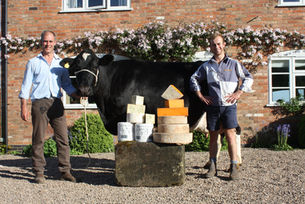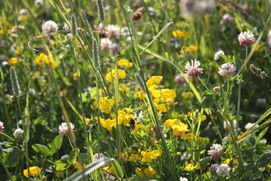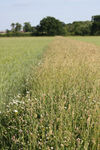
Sparkenhoe Farm
Our families have been farming in the area for generations and have been invaluable in helping get the business off the ground! The farm is set in 380 acres of rolling Leicestershire countryside, with 250 acres of that being lush, green, clover-covered pastures and 130 acres being arable and cover crops. The dairy enterprise is run by David and the arable by William, William also runs 150 Romney ewes and 100 lambs across cover crops.
David tries to grow as much of the feed on the farm as possible and buffer feeds the cows all year round to help produce milk as consistently as possible for the cheese making. Calving takes place all year round for the same reason. We milk 150 dairy cows that are all pedigree Holstein-Friesian and all have names such as Greeta and Hyacinth (The herd was in the semi-final of the National Herds Gold Cup award).
We believe that we have a responsibility to farm in a way that protects our planet, the ecosystems and the soil that we rely on to produce our food. To enable us to achieve these goals we have chosen a farming practice that regenerates the soil and the ecosystem, this method is called regenerative farming.
Regenrativley Farming
What is regenerative Agriculture?
(as described by Groundswell)
Regenerative Agriculture is any form of farming, i.e. the
production of food or fibre, which at the same time improves
the environment. This primarily means regenerating the soil.
It’s a direction of travel, not an absolute.
In the past we accepted that soils got worse as we farmed.
Now we know that they don’t have to. If we mimic a permanent
pasture whilst growing annual crops, we can start to reverse
the degradation. This gives us the Groundswell ‘5 Principles of Regenerative Agriculture’ to follow:
1. Don’t disturb the soil.
Soil supports a complex network of worm-holes, fungal hyphae and a labyrinth of microscopic air pockets surrounded by aggregates of soil particles. Disturbing this, by ploughing or heavy doses of fertiliser or sprays will set the system back.
2. Keep the soil surface covered.
The impact of rain drops or burning rays of sun or frost can all harm the soil. A duvet of growing crops, or stubble residues, will protect it.
3. Keep living roots in the soil.
In an arable rotation there will be times when this is hard to do but living roots in the soil are vital for feeding the creatures at the base of the soil food web; the bacteria and fungi that provide food for the protozoa, arthropods and higher creatures further up the chain. They also keep mycorrhizal fungi alive and thriving and these symbionts are vital for nourishing most plants and will thus provide a free fertilising and watering service for crops.
4. Grow a diverse range of crops.
Ideally at the same time, like in a meadow. Monocultures do not happen in nature and our soil creatures thrive on variety. Companion cropping (two crops are grown at once and separated after harvest) can be successful. Cover cropping, (growing a crop which is not taken to harvest but helps protect and feed the soil) will also have the happy effect of capturing sunlight and feeding that energy to the subterranean world, at a time when traditionally the land would have been bare.
5. Bring grazing animals back to the land.
This is more than a nod to the permanent pasture analogy, it allows arable farmers to rest their land for one, two or more years and then graze multispecies leys. These leys are great in themselves for feeding the soil and when you add the benefit of mob-grazed livestock, it supercharges the impact on the soil.
For more information on Regenerative agriculture go to: Karl Ritz - The Groundswell 5 Principles and Soil Sense - Groundswell Groundswell (groundswellag.com)


Romney Sheep
Our sheep are a key element to farming regeneratively, they graze species rich herbal lays all year round and diverse cover crops over the winter period which will improve soil structure and health, provide resilience during dry periods, reduce the amount of fertiliser required , benefit carbon sequestration and improve biodiversity of insect and bird species.
The diversity of crops will also reduce illness in the sheep, the deeper rooting plants mine minerals from deep within the soil and some of the herbs also contain tannins. Tannins help the sheep fight worms which are a major problem in the UK sheep flock.

Holstein Friesian Cattle
Are girls are Pedigree Holstein Friesian cows. For most of the year the cows will be grazing the lush pastures at Sparkenhoe Farm. Our permanent pastures contain a diverse range of grasses and herbs, 30% of our grass land is white clover, other grasses include Perennial Ryegrass, Timothy and Fescue.
Due to the cold and wet climate during the winter it is not possible to graze the herd all year round, the grass doesn't grow and the fields are too wet. In the winter months the cows come into the big opened sided barn, here they have lots of sunlight, a lovely straw bed and back scratchers whenever they need a good massage. During these months their feed consists of food that has been home grown on the farm over the summer period.
In early summer we start cutting the grass to make silage for the cows winter food. We try to take up to three cuts of silage over the warmer months. The silage is a mixed species sward and contains 4 different types of clover. Clover fixes nitrogen, and is great for pollinators and massively reduces the amount of chemical fertiliser required.


Arable
We grow a mixture of crops to feed to the cows during the winter months on rotation, these include peas, barley, triticale and vetch.
All our crops are direct drilled, this means that we don't cultivate the soil before drilling, (we don't disturbed the soil) and therefore drill straight into the previous crops stubble.
The benefits to direct drilling are; lower costs in energy and inputs, improves soil structure, reduces soil erosion and run off, and benefits the invertebrates and earth worms.


























